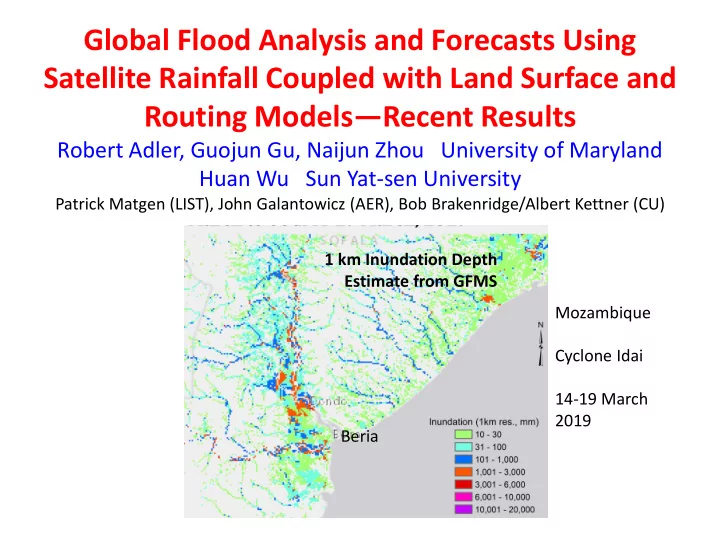

Global Flood Analysis and Forecasts Using Satellite Rainfall Coupled with Land Surface and Routing Models — Recent Results Robert Adler, Guojun Gu, Naijun Zhou University of Maryland Huan Wu Sun Yat-sen University Patrick Matgen (LIST), John Galantowicz (AER), Bob Brakenridge/Albert Kettner (CU) 1 km Inundation Depth Estimate from GFMS Mozambique Cyclone Idai 14-19 March 2019 Beria
http://flood.umd.edu/ Global Flood Monitoring System (GFMS) Global Real-time Flood Calculations Using Satellite Rainfall and Hydrological Model GPM rainfall into land surface and routing models for water depth and stream flow GPM Multi-satellite Rainfall calculations compared (IMERG) Land Surface Model Routing Model to flood thresholds Indus River basin 12 km/ 3 hr Global resolution Flood Detection Additional Routing and Inundation Time Histories at a Point Mapping at 1 km Flood resolution Threshold --globally Developed by Huan Wu (SYSU)
Global Flood Monitoring System (GFMS) GFMS now uses NASA’s Global Precipitation Measurement (GPM) mission IMERG multi-satellite rainfall product in “real - time” system with flood thresholds values based on long-term retrospective calculations (flood.umd.edu) IMERG is used at 1/8 th degree lat./long., 3-hour resolution as input to VIC land-surface model and routing at 12 and 1 km resolution Products include 1 km inundation/depth calculation Analyses are available at flood.umd.edu and various data are available for download Connected to GPM website, NASA Disasters Portal, Flood Observatory (U. of Colorado), Global Flood Partnership (GFP) Focus here is on examples of recent events and potential for integration with other remote-sensing flood observations
Mozambique Cyclone Idai March 2019 Numerous Remote Sensing- based flood products UMD GFMS SAR AER AER FloodScan FloodScan
X Beria
Cyclone Idai Just Before Landfall (14 March 2019) Satellite Mozambique Beria X Indian Ocean
Forecast Rain Before Cyclone Hit 3-Day Forecast Rain from 14 March (from NASA GEOS NWP model) X Beria NWP forecast peak totals were ~ 1000 mm, while peak satellite estimates (IMERG) were ~ 600 mm. Ground validation was missing/questionable. 3-Day Satellite-based X Beria Rain from 14-17 March
Flood Forecasts from NWP Rain vs. Nowcast Using Satellite Rain Nowcast using Satellite Rainfall Forecast from 14 March for 17 March for 17 March Flood Detection/Intensity (Depth) Forecast Nowcast X Beria X Beria Forecast at coarse (12 km) resolution gives good warning of where flooding may occur both in Mozambique and Zimbabwe, with less intensity due to difference in peak rain amounts
Mean Rainfall During March 4-21, 2019 IMERG (satellite) vs GPCC (gauges) Although validation (gauges) are missing/questionable, it appears IMERG underestimated, especially at high end. At least one gauge in each 1º grid
Hurricane Florence (Carolinas, USA) Mean precipitation during September 13-18, 2018 IMERG vs CPC Gauge PDF Matching At least one gauge in each 0.25º grid
Timeline of Useful Inundation First Estimate of Inundation — from GFMS Maps 15 March--GFMS 1 km (calculation 15 March based on Satellite rainfall and 17.5 S land-surface/routing models — every 3 hrs.) 17 March — AER FloodScan (surface passive microwave signal disaggregated spatially by terrain, but obscured by rain [not cloud] 20 March — Synthetic Aperture Radar (SAR) published by UNOSAT from Sentinel-1 data 19-20 March. X Beria Number of groups analyzing Sentinel and other SAR data Later — Optical (e.g., MODIS) obscured by clouds How to use these resources in an 21.0 S integrated fashion taking into account timelines and quality?? 33.0 E 37.0 E
19 March AER FloodScan GFMS 1 km Inundation X Beria X Beria Passive microwave surface signals relate to non- typical surface water, very high soil moisture at coarse (15 km) resolution. Fine-scale inundation uses coarse-scale fractional water and topography
SAR-based Inundation Maps NASA/JPL UNOSAT Flood Observatory LIST U. Of Colorado Luxembourg
Mozambique Floods — Inundation/Water Depth from GFMS 19-20 March (Max 14-19 March 2019) GFMS SAR X BERIA X BERIA 50 km
GFMS and SAR (LIST) Inundation Comparison March 19, 2019 X BERIA POD: 13% FAR: 21% CSI: 13%
Other Examples (with similar results) March 19, 2019 March 20, 2019 March 20, 2019
Time Integrated Inundation from GFMS Maximum Inundation from GFMS (14-19 March) vs. Max Inundation from SAR (LIST) POD: 47% FAR: 57% CSI: 29% Better agreement with SAR — Higher POD, but lower FAR
Streamflow/Flood Estimates from RiverWatch (Flood Observatory) and GFMS RiverWatch Station # 260 19.39S, 34.51E Uses surface microwave Punge R. observations related to streamflow GFMS Streamflow Satellite rainfall into land Flood Threshold surface/routing models
Mozambique Flood Example Next Steps? Real-time users need accurate information, quickly. Multiple sources are available, at different time and space resolutions (and different latencies) and with different positive qualities and limitations. With multiple sources, users need info. to be “easy to compare” or integrated . Integrated Products Individual products (e.g., inundation estimates) will continue to improve with better observations, algorithms and modeling — but there will always be limitations in accuracy, availability, etc. So, we also need to be working toward melding or integrating our multiple estimates into a “best” estimate. For inundation, one possible approach: Daily, model-based estimate as base, with optical and SAR products as additional options where/when available. All remapped and available as layers (if available); possible merger or best estimate as separate product. A technical starting point is simple comparisons to understand strengths/weaknesses, with possible product approaches driven by user interests. Some ideas are being tested/applied at Flood Observatory This type of work needs programmatic integration too; a great place for leadership by certain funding agencies working together, but also “steering” by entities like the Global Flood Partnership (GFP)
Zhujiang (Pearl) River Ramada Pearl Guangzhou X Xijiang River
Overbank flooding Inundated cell without expanding GFMS Non-inundated potential flooding Not inundated Inundation Algorithm Inundated cell 1 km Streamflow Criteria and assumption: (1) mass balance; (2) inundation only happens in floodplain across the river reach with a level water surface; (3) inundation process finishes within the same time interval as the routing model; (4) inundation buffer area doesn’t include the grid cells with higher river order.
Recommend
More recommend